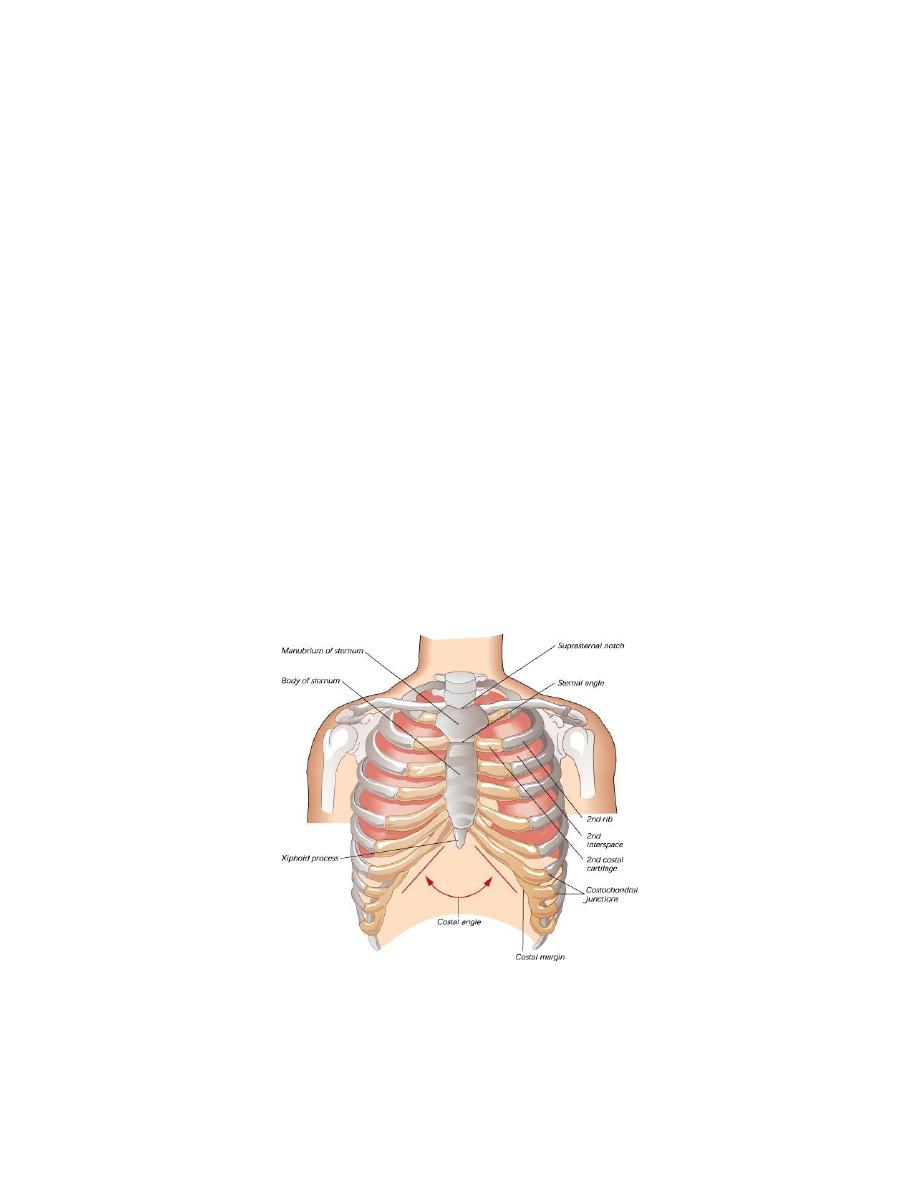
Lecture 1
Thorax
د.رندعبداللطيف
Part 1 : Thoracic wall
The thorax (or chest) is the region of the body between the neck and the abdomen.
It is flattened in front and behind but rounded at the sides. The framework of the
walls of the thorax, which is referred to as the thoracic cage, is formed by the
vertebral column behind, the ribs and intercostal spaces on either side, and the
sternum and costal cartilages in front. Superiorly, the thorax communicates with
the neck, and inferiorly it is separated from the abdomen by the diaphragm. The
thoracic cage protects the lungs and heart and affords attachment for the muscles of
the thorax, upper extremity, abdomen, and back. The cavity of the thorax can be
divided into a median partition, called the mediastinum, and the laterally placed
pleurae and lungs.
Structure of the Thoracic Wall
The thoracic wall is covered on the outside by skin and by muscles attaching the
shoulder girdle to the trunk. It is lined with parietal pleura. The thoracic wall is
formed posteriorly by the vertebral column; anteriorly by the sternum and costal
cartilages; laterally by the ribs and intercostal spaces; superiorly by the
suprapleural membrane; and inferiorly by the diaphragm, which separates the
thoracic cavity from the abdominal cavity.
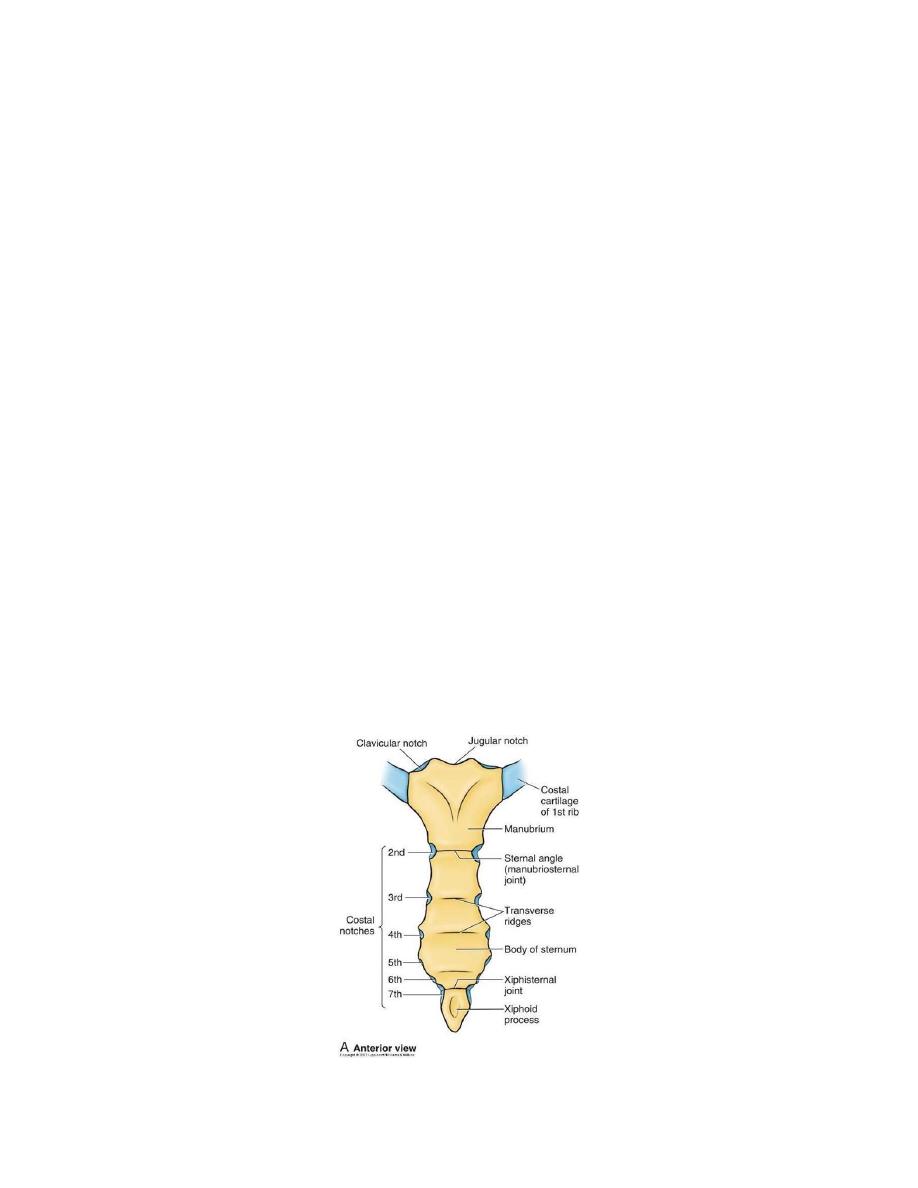
Lecture 1
Thorax
د.رندعبداللطيف
Sternum
The sternum lies in the midline of the anterior chest wall. It is a flat bone that can
be divided into three parts:
1. Manubrium sterni.
2. Body of the sternum.
3. Xiphoid process.
The manubrium is the upper part of the sternum. It articulates with the body of
the sternum at the manubriosternaljoint, and it also articulates with the clavicles
and with the1st costal cartilage and the upper part of the 2nd costal cartilages on
each side. It lies opposite the 3
rd
and 4th thoracic vertebrae.
The body of the sternum articulates above with the manubrium at the
manubriosternal joint and below with the xiphoid process at the xiphisternal
joint.
On each side, it articulates with the 2nd to the 7th costal cartilages
The xiphoid process is a thin plate of cartilage that becomes ossified at its
proximal end during adult life. No ribs or costal cartilages are attached to it.
The sternal angle (angle of Louis), formed by the articulation of the manubrium
with the body of the sternum, can be recognized by the presence of a transverse
ridge on the anterior aspect of the sternum. The transverse ridge lies at the level of
the 2nd costal cartilage, the point from which all costal cartilages and ribs are
counted. The sternal angle lies opposite the intervertebral disc between the 4th and
5th thoracic vertebrae. The xiphisternal joint lies opposite the body of the ninth
thoracic vertebra.
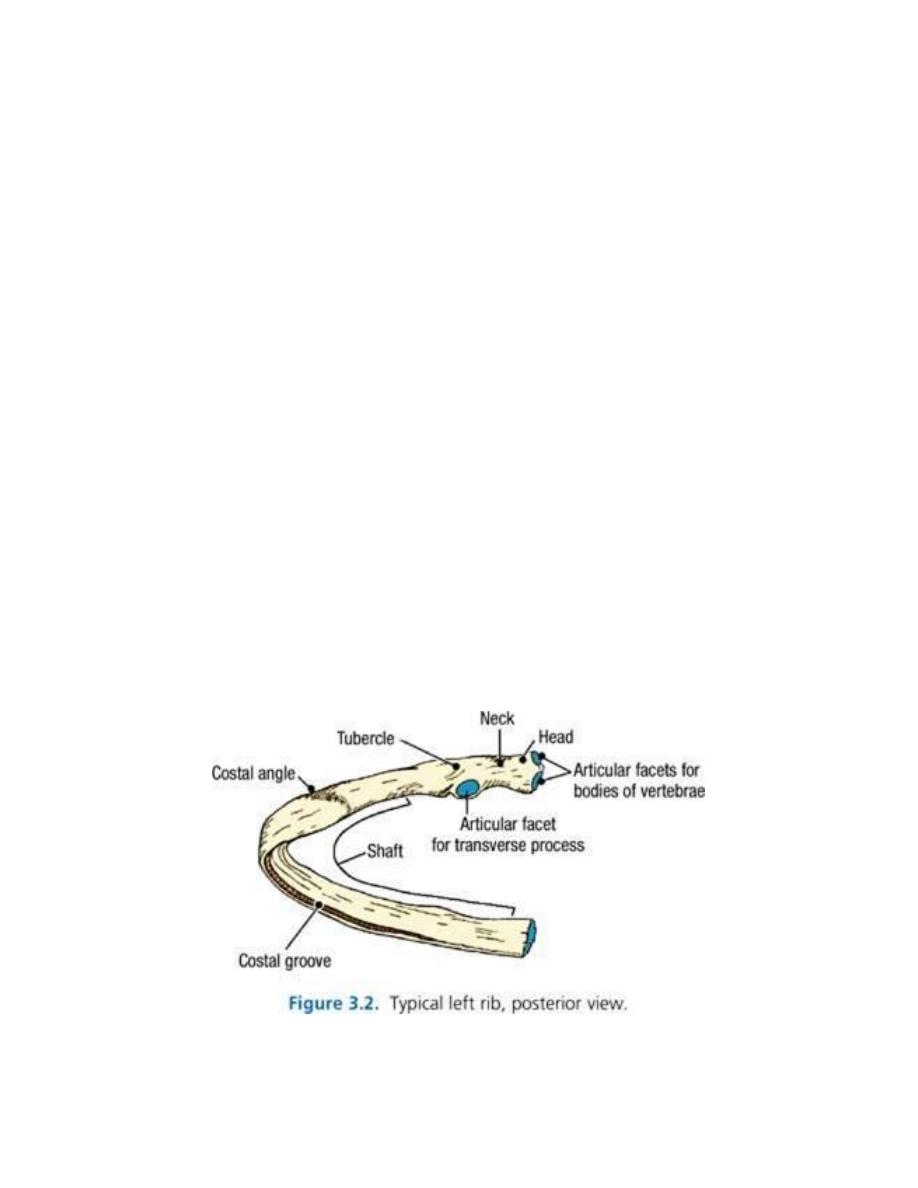
Lecture 1
Thorax
د.رندعبداللطيف
Ribs
There are 12 pairs of ribs, all of which are attached posteriorly to the thoracic
vertebrae. The ribs are divided into three categories:
1. True ribs: The upper seven pairs are attached anteriorly to the sternum by
their costal cartilages.
2. False ribs: The 8th, 9th, and 10th pairs of ribs are attached anteriorly to
each other and to the 7th rib by means of their costal cartilages and small
synovial joints.
3. Floating ribs: The 11th and 12th pairs have no anterior attachment.
Typical Rib
A typical rib is a long, twisted, flat bone having a rounded, smooth superior border
and a sharp, thin inferior border. The inferior border overhangs and forms the
costal groove, which accommodates the intercostal vessels and nerve. The anterior
end of each rib is attached to the corresponding costal cartilage.
A rib has a head, neck, tubercle, shaft, and angle. The head has two facets for
articulation with the numerically corresponding vertebral body
and that of the vertebra immediately above. The neck is a constricted portion
situated between the head and the tubercle. The tubercle is a prominence on the
outer surface of the rib at the junction of the neck
with the shaft. It has a facet for articulation with the transverse process of the
numerically corresponding vertebra. The shaft is thin and flattened and twisted on
its long axis. Its inferior border has the costal groove. The angle is where the shaft
of the rib bends sharply forward.
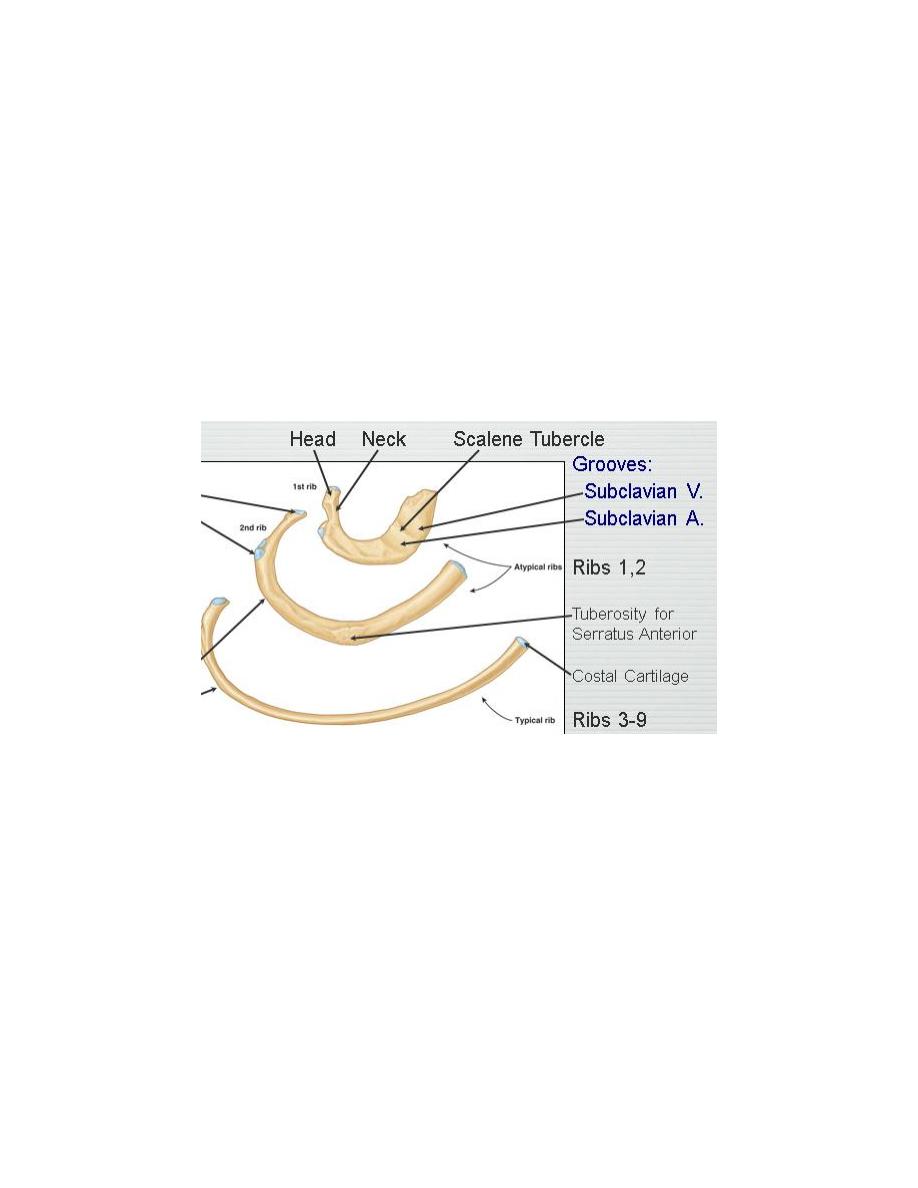
Lecture 1
Thorax
د.رندعبداللطيف
Atypical ribs:
The first rib:
- Short, acutely curved, has superior & inferior surfaces instead of medial & lateral
surfaces
- The head has single facet for T1
- The superior surface is rough & characterized by the scalene tubercle for
insertion of Scalenus anterior muscle which separates the area of subclavian vein
in front from that of subclavian artery behind
- No costal groove
The second rib:
- Is midway in position between the 1st & typical ribs
The tenth rib: Has only single articular facet on the head.
The eleventh rib: Single head facet, No tubercle facet, poorly defined angle.
The twelfth rib: Is a small & thin piece of bone lacking most of the costal features
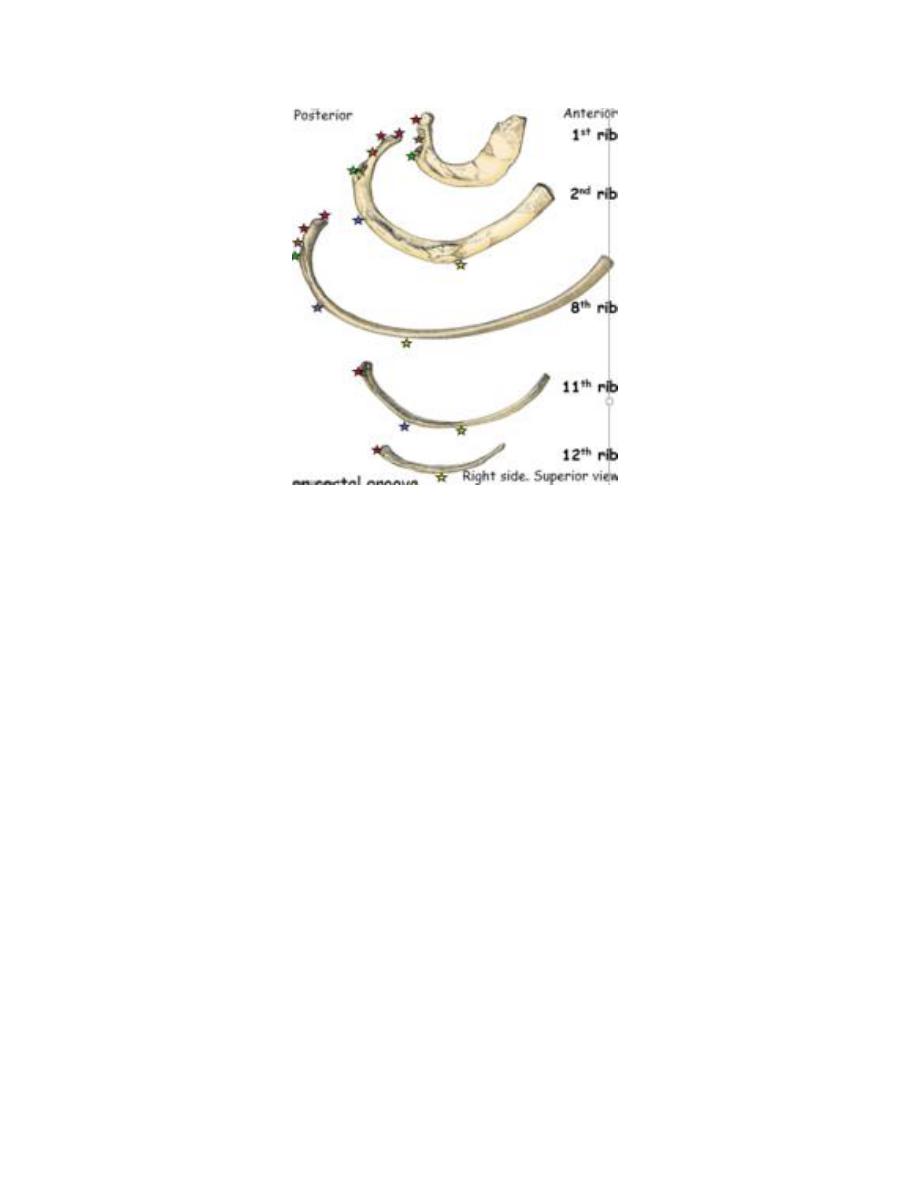
Lecture 1
Thorax
د.رندعبداللطيف
General Characteristics of a Vertebra
The typical vertebra consists of a rounded body anteriorly and a vertebral arch
posteriorly. These enclose a space called the vertebral foramen, through which
run the spinal cord and its coverings. The vertebral arch gives rise to seven
processes: one spinous, two transverse, and four articular processes are vertically
arranged and consist of two superior and two inferior processes. The spinous
process, or spine, is directed posteriorly.
The thoracic spines are long and inclined downward. The body is medium size and
heart shaped
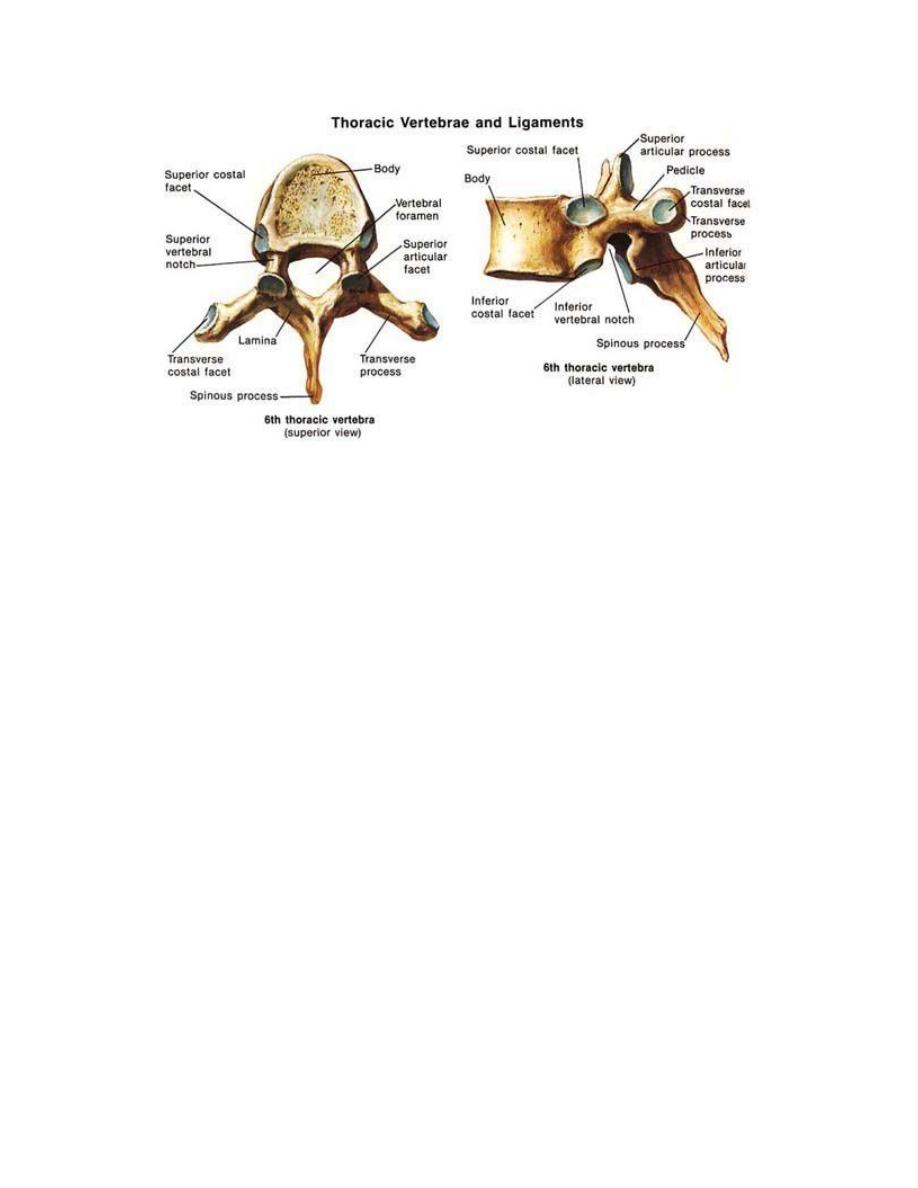
Lecture 1
Thorax
د.رندعبداللطيف
Openings of the Thorax
Thoracic outlet: It is narrow aperture communicates the chest cavity with the root
of the neck. It is called an outlet because trachea, esophagous and important
vessels and nerves emerge from the thorax here to enter the neck and upper limbs.
On either side of these structures, the outlet is closed by a dense fascial layer called
the suprapleural membrane. The opening is attached at its apex to the tip of the
transverse process of the C7, laterally by the medial borders of the 1st ribs and
their costal cartilages, and anteriorly by the superior border of the manubrium
sterni. It is obliquely placed. It protects the underlying cervical pleura and resists
the changes in intrathoracic pressure occurring during respiratory movements.
The thoracic cavity communicates with the abdomen through a large opening
which is bounded posteriorly by the 12th thoracic vertebra, laterally by the curving
costal margin, and anteriorly by the xiphisternal joint. Through this large opening,
which is closed by the diaphragm, pass the esophagus and many large vessels and
nerves, all of which pierce the diaphragm.
